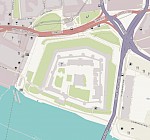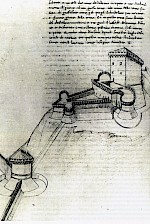The flawed defences of King’s Landing
The new feature Game of Thrones Season 4: Ice and Fire: A Foreshadowing ends with a view on the city and citadel of King’s Landing, with the all too modern buildings of Dubrovnik, Croatia, supplying the foreground for the computer generated castle. The flight over the city towards the citadel was already present in the opening scene of the Game of Thrones Season 4 trailer no. 1.
 A closer look at the pseudo-medieval defences exposes grave defects. The city houses slide up far too closely to the inner wall (1). The city buildings are at the same height as the wall, providing an attacker with excellent firing positions as well as cover to prepare attacks on the wall. On the left (2), the outer wall borders the inner wall at the same height with hardly any special defence, creating a huge vulnerability.
A closer look at the pseudo-medieval defences exposes grave defects. The city houses slide up far too closely to the inner wall (1). The city buildings are at the same height as the wall, providing an attacker with excellent firing positions as well as cover to prepare attacks on the wall. On the left (2), the outer wall borders the inner wall at the same height with hardly any special defence, creating a huge vulnerability.
 Should an attacker not use the opportunity on the left to bypass the second inner defensive line via the ramparts (3), the first courtyard of the castle, a service area, provides excellent cover to prepare a more direct attack. An attack on the left is highly advisable as the distribution of the towers is highly imbalanced too: One to three towers on the left vs. six to eight on the right.
Should an attacker not use the opportunity on the left to bypass the second inner defensive line via the ramparts (3), the first courtyard of the castle, a service area, provides excellent cover to prepare a more direct attack. An attack on the left is highly advisable as the distribution of the towers is highly imbalanced too: One to three towers on the left vs. six to eight on the right.
Having taken the second interior defensive line, the attack on the interior main gate, the last obstacle before the citadel itself, is assisted by a lot of dead ground in front of the gate where troops can rest and prepare for their assault (4).
 Compare this defence with a true medieval fortress complex, the Tower of London which is located close to the medieval city but clearly separated from it by defensible terrain and walls that allow for a coordinated defence. The city of Dubrovnik itself is also much better hardened against a land-based attack than the palace of King’s Landing.
Compare this defence with a true medieval fortress complex, the Tower of London which is located close to the medieval city but clearly separated from it by defensible terrain and walls that allow for a coordinated defence. The city of Dubrovnik itself is also much better hardened against a land-based attack than the palace of King’s Landing.
 While castles and city fortifications were prominently featured in illuminated manuscripts and the art of creating impregnable fortresses highly developed, the systematic architectural study of fortifications and the development of new types, such as the start fort imagined by the Sienese painter and architect Francesco di Giorgio Martini (1439-1502), only became common in the late medieval/early modern period. The new types of fortifications became necessary due to the increased power of artillery. The next version of the virtual citadel of King’s Landing could benefit from studying such works to make it more realistic.
While castles and city fortifications were prominently featured in illuminated manuscripts and the art of creating impregnable fortresses highly developed, the systematic architectural study of fortifications and the development of new types, such as the start fort imagined by the Sienese painter and architect Francesco di Giorgio Martini (1439-1502), only became common in the late medieval/early modern period. The new types of fortifications became necessary due to the increased power of artillery. The next version of the virtual citadel of King’s Landing could benefit from studying such works to make it more realistic.
Further reading
- Christopher Duffy, Fire and Stone: The Science of Fortress Warfare 1660-1860. 1996.
- David Macaulay, Castle. 1982 (illustrated children’s book).
- Marc Morris, Castle - A History of the Buildings that Shaped Medieval Britain. 2012 (TV tie-in book).
- Dan Snow, Battle Castles: 500 Years of Knights and Siege Warfare. 2012 (TV tie-in book).
Picture credit: Annotated trailer screenshot © HBO
Map credits: The Tower of London; the City of Dubrovnik, Croatia © Open Street Map contributors
Picture credit: Drawing of the Rocca Torrione in Cagli, Italy, by Francesco di Giorgio Martini in the Codice Magliabechiano di Francesco di Giorgio Martini, Biblioteca Nazionale Centrale di Firenze (via Wikimedia commons).




